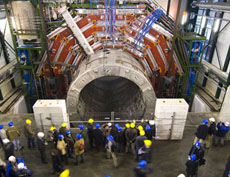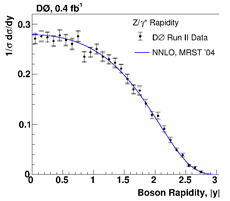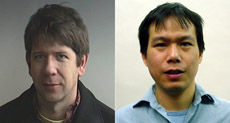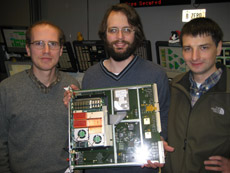|
Thurs., March 8
1:00 p.m.
ALCPG ILC Physics and Detector Seminar -
CANCELLED
2:30 p.m.
Theoretical Physics Seminar -
Curia II
Speaker: H. Fritzsch, Ludwig-Maximilians University, Munich
Title: Fundamental Constants in Physics and Their Time Dependence
3:30 p.m.
DIRECTOR'S COFFEE BREAK -
2nd Flr X-Over
4:00 p.m.
Accelerator Physics and Technology Seminar -
1 West
Speaker: R. Wallny, University of California, Los Angeles
Title: A Beam Condition Monitoring System for the CDF Experiment
Fri., March 9
3:30 p.m.
DIRECTOR'S COFFEE BREAK -
2nd Flr X-Over
4:00 p.m.
Joint Experimental-Theoretical Physics Seminar -
1 West
Speaker: M. Ross, Fermilab
Title: The Reference Design Report and Cost Estimate for the
International Linear Collider
Click here for NALCAL,
a weekly calendar with links to additional information. |
Thursday, March 8
-Minnesota Wild Rice with Chicken
-Tuna Melt on Nine Grain
-BBQ Ribs
-Chicken Casserole
-Buffalo Chicken Wrap
-Assorted Slice Pizza
-Toasted Pecan Chicken Salad
Wilson Hall Cafe Menu |
|
Thursday, March 8
Dinner
-Risotto Cakes with Shrimp with Mustard Sauce
-Medallions of Beef with Cabernet Sauce
-New Potatoes with Dill
-Green Beans with Lemon Zest
-Gran Marnier Soufflé
Wednesday, March 14
Lunch
-Beef Fajitas
-Pico de Gallo
-Rice and Beans
-Rum Pecan Cake
Chez Leon Menu
Call x4598 to make your reservation. |
|
|
High-energy plasma,
high-impact accelerator
In the February 15 issue of Nature, researchers from SLAC and their colleagues revealed that they had successfully doubled the energy of electrons within a very short distance. The particles gained as much energy in 85 cm--shown in the photo at right--as they currently do in SLAC's two-mile-long linear accelerator. While some physicists believe this advance could be the wave of the future for particle accelerators, others believe we still have a long way to go.
The technology, called plasma wakefield acceleration, shoots an electron beam through an ionized gas to create a charged field. Plasma electrons are pushed out of the front of the beam and then congregate at its tail, resulting in acceleration of particles at the rear of the bunch. Electrons in the tail ride along with this wakefield like a surfer on a wave. "Accelerators transform low-energy, high-current electrical energy into high-energy, low-current beams," said Marc Ross, who spent 27 years at SLAC before becoming head of Fermilab's Technical Division. "The SLAC group has extended this tremendously, using careful beam manipulation and specially prepared plasma cells."
Most of the electrons in the plasma accelerator lose energy to the plasma wave, and only a small fraction reach peak energies. Producing enough high-energy particles in an area sufficiently focused to be useful for collisions would be a very big step, said AD's Valeri Lebedev. "The plasma wave also lives only a very short time," he added. "From a science point of view I appreciate the work, but we need to be careful about making statements about the future."
Alvin Tollestrup of the Experimental Particle Physics Division thinks this result sounds promising. "There have been several papers with spectacular progress, but this Nature paper is by far the biggest step forward," he said. Ross added that although this research is difficult to extrapolate to the future of high-energy physics, he believes that the ground-breaking advances in beam dynamics, instrumentation and control have facilitated experiments like this one. "I think it's fascinating. The interaction of particle beams with other types of matter--plasmas, lasers, even themselves--is a big part of the future of accelerator physics," he said. "I'm looking forward to the group's next result."
--Christine Buckley
|
Jewish music and poetry of Renaissance Italy, March 17

As part of an eight-concert US tour, the international group Ensemble Lucidarium will perform "La Istoria de Purim: Music and Poetry of the Jews in Renaissance Italy," on March 17 in the Ramsey Auditorium. The group will play songs created by three Israelite communities that came together in the 15th and 16th centuries in Italy: the Ashkenazy from North of the Alps, the Sepharadi from the Iberian Peninsula and the Italikims, who had been in Italy since the days of the Roman Empire. The show starts at 8:00 p.m. Tickets cost $10. To order, call 630/840.ARTS (2787) weekdays from 9-4 (closed for lunch). For more information, call 630-840-2986 weekdays 9-12 or visit the Lucidarium web page at www.lucidarium.com
|
The CMS "Top 100"

On February 28, the central, and heaviest, section of the CMS detector was lowered 100 meters underground into the CMS cavern. This photo was taken soon after the section began its descent into the cavern.
Copyright CERN.
It takes audacity to throw away all but a hundred of every 40 million data points. How can you be sure you're saving the precious few that may lead to discovery? For the CMS high-energy physics experiment, the response involves gambling
-fortunately, these scientists have a good hand.
Read More
|
Physorg.com, March 7, 2007:
Particle X in rare decay could belong to a new physics model
A particle that may mediate the rare decay of a Sigma-plus hyperon appears to have close affiliations with a light Higgs boson found in one supersymmetric model-an interpretation suggesting unambiguous evidence for physics beyond the standard model (SM), scientists say.
Xiao-Gang He of the National Taiwan University, Jusak Tandean of the University of La Verne, and German Valencia of Iowa State have investigated the so-called HyperCP result observed at Fermilab a little over two years ago. While the HyperCP Collaboration began as a search for CP symmetry violation, the rare decay of the Sigma-plus hyperon (made of a strange quark and two up quarks) opens the possibility for the existence of a new particle with unusual characteristics.
Read More |
|
|
Cleaning up the mess

The angular distribution of Z-boson/photon events seen by the DZero experiment. The black dots represent the data measurements and the blue curve represents a prediction based on a parameterized Parton Distribution Function.
As high-energy particle colliders go, the Tevatron is a messy place. You see, the protons and anti-protons circling around the Tevatron are not hard, solid objects that collide like billiard balls. In fact, they are mostly just empty space, made up of three quarks (or anti-quarks for the anti-proton) held together by gluons. And because they are bound together, the quarks (and gluons) must share the immense momentum generated when the Tevatron accelerates the protons and anti-protons. When they do happen to cross each other's path, all the interactions occur between an individual quark or gluon from the proton, and an anti-quark or gluon from the anti-proton. But it is difficult to predict who will interact with what and with which momentum. In other words, a mess: imagine how your billiards game would suffer if the balls were just loose bags of marbles.
However, Tevatron physicists have the right tool for the job of cleaning up this mess. In many proton/anti-proton collisions, a quark and anti-quark will annihilate and form a Z boson or an energetic photon, which then decays to two leptons. This process, known as Drell-Yan production, is very sensitive to the fraction of the proton momentum carried by the quark. In the billiards analogy, Drell-Yan production allows physicists to measure the momentum of the cue ball by observing the other balls on the pool table. Using the information carefully gleaned from Drell-Yan production and other measurements, physicists create descriptive models for how the quarks/anti-quarks and gluons share momentum within protons/anti-protons, called Parton Distribution Functions. These models are used as part of the foundation for all physics studied at the Tevatron.
The DZero experiment has just released a new measurement of Drell-Yan production. DZero has the capability to probe poorly known
regions of the proton/anti-proton Parton Distribution Functions by
extending the measurement of Z-bosons or gammas down to very small angles with respect to the proton/anti-proton initial directions. The DZero results agree well with the most precise theoretical predictions for the process, and represent the most accurate measurement to date. With this careful measurement of Drell-Yan production, DZero physicists have gone a long way to clean up the Tevatron's mess. This success will be essential for scientists trying to understand physics in the even larger mess of the Large Hadron Collider (LHC) when it turns on later this year.

Above: Terry Toole (left) and Ming Yan (right) of the University of Maryland developed the analysis to measure Drell-Yan production. Below: Ernest Aguilo (left, University of Alberta) and Mikolaj Cwiok (right, University College Dublin), Level 2 trigger experts, are passing the torch to Jim Kraus (center, Michigan State University). Nearly every event recorded by the DZero experiment must satisfy Level 2 trigger conditions.

|
|
Upcoming classes:
Access 2003: Advanced - March 20 & 22 (morning only)
This class will provide you with advanced capabilities of Access to work with improperly structured data, perform summary operations on data, create macros to automate tasks and enhance forms and reports. More information and enrollment here.
Excel Shortcuts: March 20 & 22 (afternoon only)
Learn the quickest way to navigate among worksheets. Create your own toolbars to help customize your worksheets and job functions. Learn shortcut menus, the most efficient ways to enter text and much more. More information and enrollment here.
The hunt for dark matter workshop
There will be a symposium on dark matter, focusing on collider, detector and indirect searches from May 10 to 12 at Fermilab. The organizers are currently accepting abstracts for the event. You can register and submit an abstract here, or contact an organizing committee member with questions.
Upcoming Activities
|
|